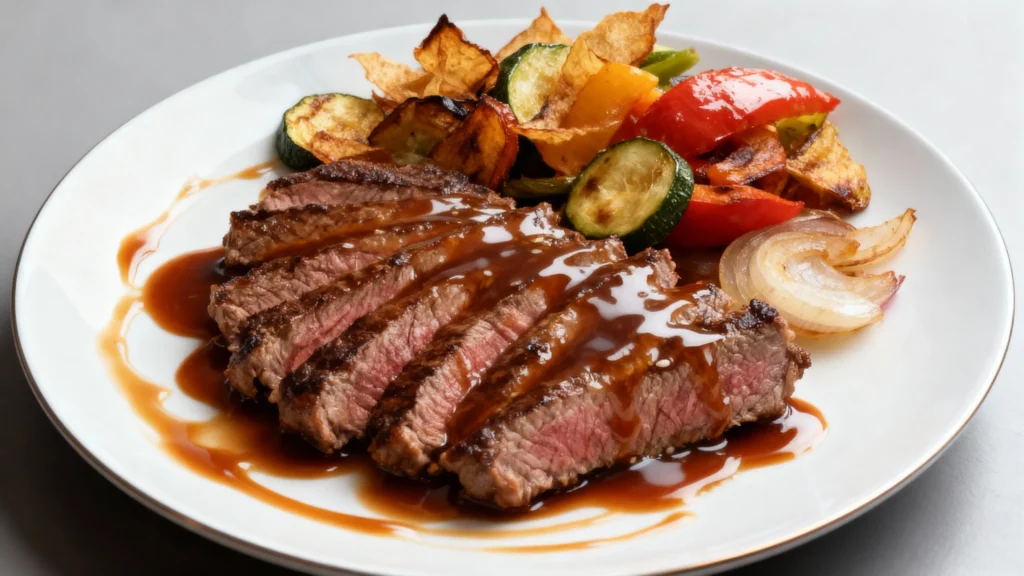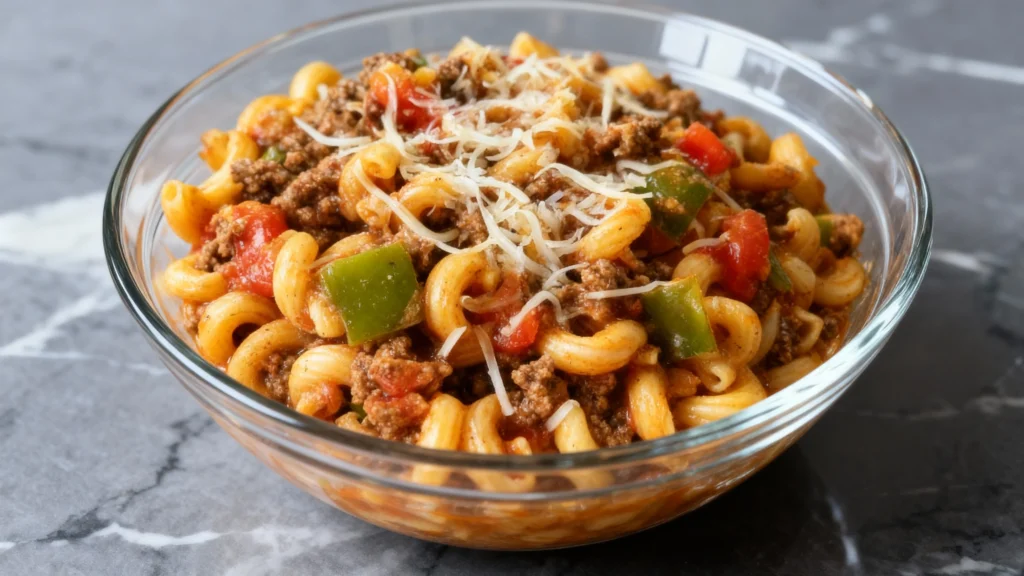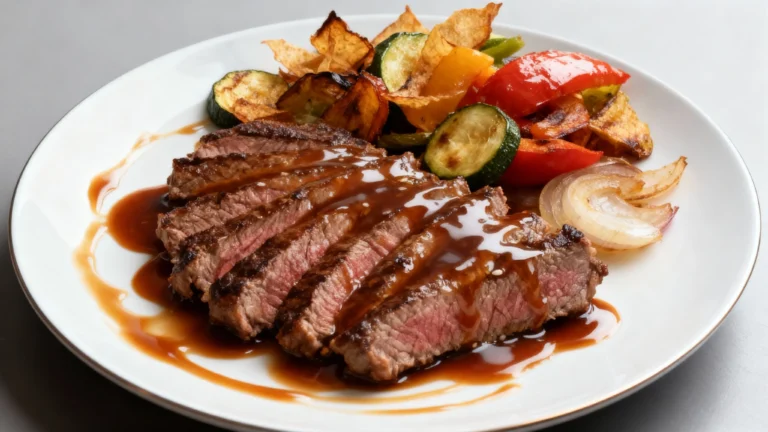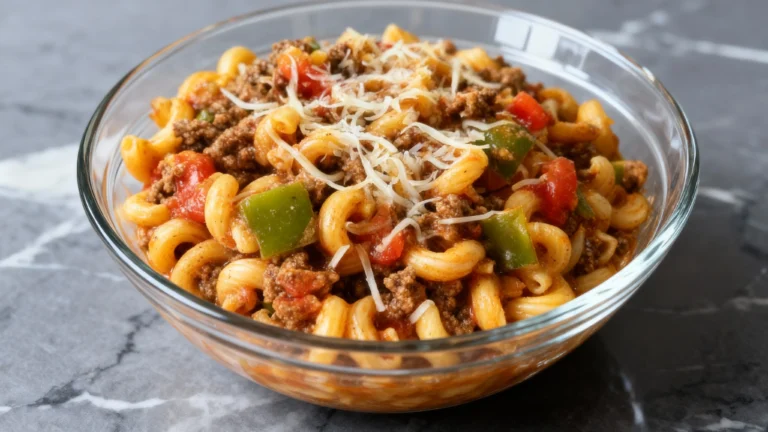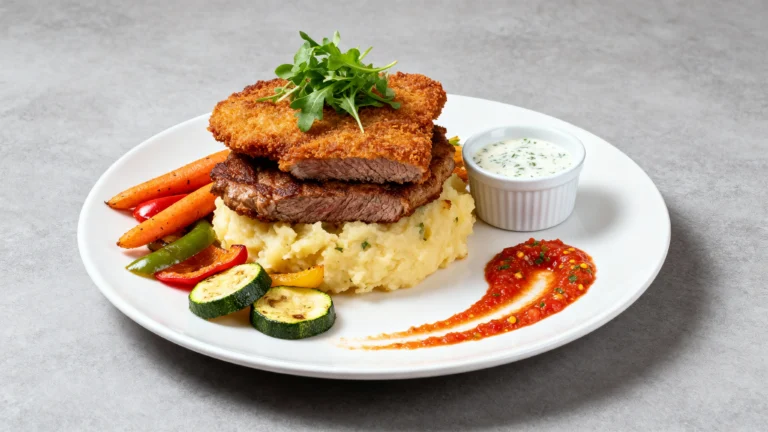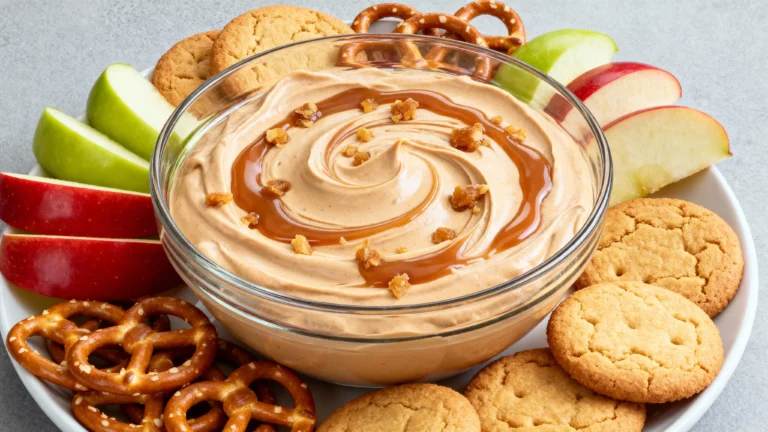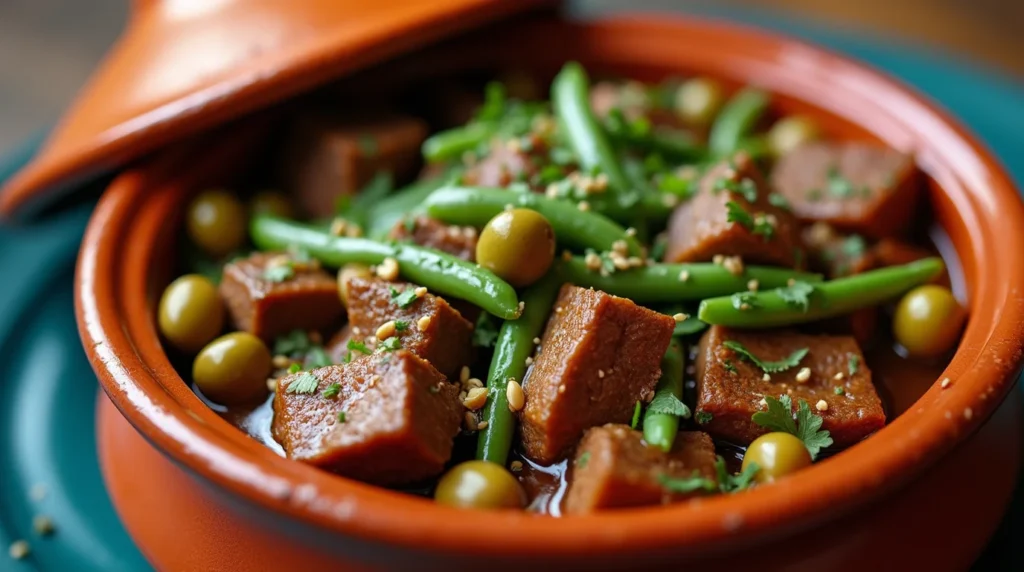
Beef Tagine with Green Beans and Olives: 5 Surprising Reasons You’ll Love It
Share this recipe
The first time I tasted beef tagine with green beans and olives, it was magical. The smell of Moroccan cooking filled my kitchen. It took me to Marrakech’s busy markets with every bite.
This dish is more than food; it’s a trip into North African cooking. It mixes tender meat, fresh veggies, and spices. It changes how you cook at home.
Here’s why this dish will become your new comfort food favorite.
Recipe Details
Serving Size: 4 servings | Prep Time: 30 minutes | Cook Time: 2 hours | Total Time: 2 hours 30 minutes
Ingredients per Serving
- 1 lb beef chuck, cubed
- 1 cup fresh green beans
- 1/2 cup green olives
- 2 tbsp olive oil
- Moroccan spice blend
Nutritional Facts (per serving)
- Calories: 375
- Protein: 28g
- Carbs: 12g
- Fat: 22g
- Fiber: 4g
- Sodium: 480mg
- Sugar: 3g
Key Takeaways
- Discover the authentic flavors of Moroccan cuisine
- Learn a simple yet impressive slow-cooked stew technique
- Explore the perfect balance of tender beef and fresh vegetables
- Understand the cultural significance of traditional tagine cooking
- Impress your family with a restaurant-quality meal at home
The Rich Heritage of Moroccan Tagine Cooking
Explore the world of moroccan cuisine, where cooking methods share stories as rich as the flavors. The tagine is more than a pot; it’s a time capsule of North African flavors and traditions.
Origins of Traditional Tagine Vessels
The tagine pot has its roots in North Africa, centuries old. Made from earthenware, it has a cone-shaped lid. This design lets steam circulate, keeping the dish moist.
- Made from clay or ceramic materials
- Conical lid helps retain moisture and flavor
- Slow-cooking technique preserves nutrients
Cultural Significance in North African Cuisine
In moroccan cuisine, tagines are more than food. They symbolize hospitality, family, and community. Each region has its own twist, turning simple ingredients into unforgettable dishes.
“A tagine is more than just a meal; it’s a tale passed down through generations, rich with culinary heritage and tradition.” – Moroccan Culinary Tradition
Evolution of Tagine Recipes Through Generations
Traditional cooking has evolved, yet stayed true to its roots. Families share recipes, adding new touches while keeping traditions alive.
- Preservation of ancient cooking techniques
- Integration of global ingredient influences
- Maintaining authentic flavor profiles
Essential Ingredients for Beef Tagine with Green Beans and Olives
To make a real tagine, you need the right ingredients. They must bring out deep, rich flavors. Your journey to a tasty meal begins with picking the best parts for your beef dish.
For a perfect beef in tagine, choose top-notch ingredients. They should work together to give you a meal you’ll remember. Here are the key elements:
Meat Selection
- Choose tender beef cuts like chuck or shoulder
- Look for meat with good marbling for maximum flavor
- Opt for grass-fed beef when possible
Fresh Vegetables and Aromatics
- Crisp green beans for texture and nutrition
- Briny olives to add depth and complexity
- Aromatic onions and garlic
Herbs and Spices
The heart of any tagine is its herbs and spices. Your spice blend will turn simple ingredients into a fantastic meal.
“Spices are the heart and essence of Moroccan cuisine.” – Traditional Moroccan Proverb
- Ground cumin
- Paprika
- Coriander
- Cinnamon
- Fresh cilantro and parsley
Choosing the best ingredients makes your stew a true culinary masterpiece. It will transport your taste buds on a flavorful journey to North Africa.
The Perfect Spice Blend for Your Authentic Tagine
Exploring Moroccan cuisine means diving into the world of herbs and spices. North African flavors blend aromas and tastes to make simple ingredients into amazing dishes.
Traditional Moroccan Spice Combinations
Moroccan cuisine’s heart is its spice blends. The right mix of spices is key to a great tagine. A classic blend includes:
- Ras el Hanout – a mix of up to 30 spices
- Ground cumin for earthy flavor
- Paprika for a touch of heat
- Cinnamon for sweetness
- Turmeric for color
Balancing Flavors in Your Dish
Making a spice blend that works needs to know how spices mix. Start with a little and taste as you add more. Aim for layers of flavor that enhance the beef and green beans in your tagine.
Storage and Preparation of Spice Mixtures
Keep your spices fresh by storing them in airtight containers, away from sunlight. Grind whole spices just before using for the best flavor. Using fresh, quality spices is key to a true North African taste.
“Spices are the soul of Moroccan cooking – they tell a story in every bite.” – Moroccan Culinary Tradition
Step-by-Step Guide to Preparing Your Tagine
Making a tasty Moroccan dish is an art. It turns simple ingredients into a delicious slow-cooked stew. This dish needs patience and careful preparation to get that authentic Moroccan taste.
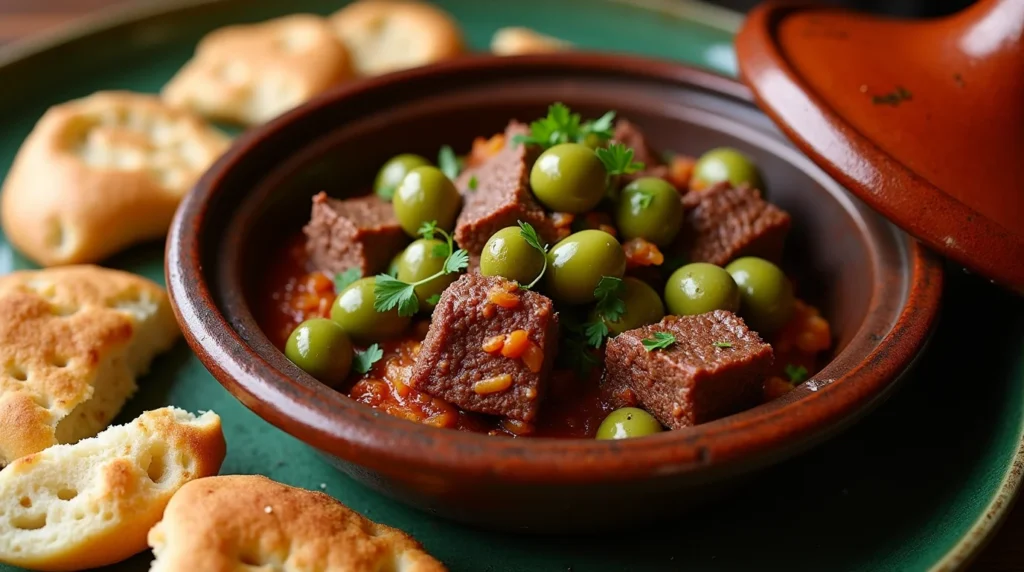
Start by gathering all your ingredients and prepping your kitchen workspace. The secret to a great tagine is layering flavors and cooking it slowly.
- Choose high-quality beef chuck or shoulder, cut into 1-inch cubes
- Season the meat well with traditional Moroccan spices
- Brown the meat in a heavy-bottomed tagine or Dutch oven
- Add aromatics like onions, garlic, and ginger
- Pour in liquid (beef broth or water) to make the base of your stew
The slow cooking is where the magic happens. Cover your pot and let it simmer gently. This way, the meat gets tender and the flavors mix well.
“Good cooking takes time. There are no shortcuts to creating a truly memorable meal.” – Unknown Chef
In the last 30 minutes, add fresh green beans and briny olives. These add brightness and texture, making your dish complete and satisfying. It will feel like you’re in Morocco.
- Cook on low heat for 2-3 hours
- Check the liquid levels now and then
- Stir gently to avoid sticking
Your beef stew is done when the meat is tender and the veggies are just right.
Why Green Beans and Olives Create the Perfect Combination
In Moroccan cuisine, green beans and olives in a traditional tagine are unmatched. They add depth and complexity to your meal.
Green beans add a fresh, crunchy texture. This contrasts well with the tender beef. Olives, with their salty flavor, add a sophisticated touch.
Texture Contrasts That Excite the Palate
- Green beans offer a delightful crunch
- Olives bring a smooth, velvety texture
- The interplay creates a dynamic eating experience
Nutritional Powerhouse of Flavor
Green beans and olives are not just tasty. They’re also packed with nutrients. They add vitamins, minerals, and antioxidants to the beef.
“In North African cuisine, each ingredient weaves a tale of tradition and sustenance.” – Moroccan Culinary Experts
Together, green beans and olives make the dish better. They enhance the flavor and offer health benefits.
Tips for Achieving Melt-in-Your-Mouth Tender Beef
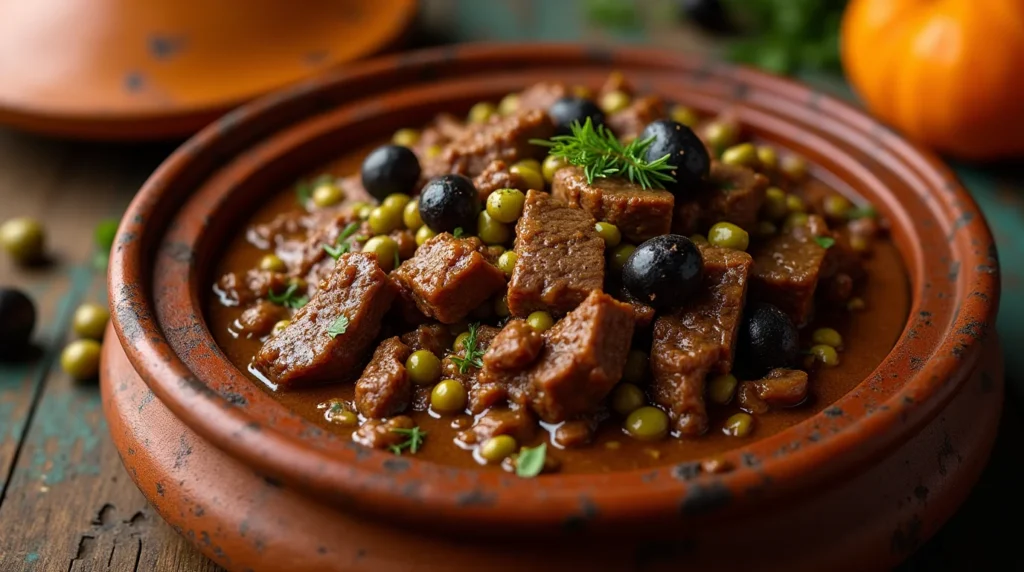
To make a tender beef slow-cooked stew, you need more than just throwing ingredients together. Learning traditional cooking techniques is key to making your tagine stand out.
The first step is to pick the right cut of meat. Choose cuts like chuck roast or beef shoulder. These have lots of connective tissues that soften during slow cooking, making the beef incredibly tender.
“Great tagine is about patience and technique, not just ingredients.”
- Choose meat with good marbling for maximum flavor
- Cut beef into uniform 1-2 inch chunks for even cooking
- Trim excess fat but leave some for rich flavor
Your cooking method is crucial. Cooking low and slow is the best way to get tender beef. Try to cook your tagine at 275-300°F. This lets collagen break down slowly.
- Marinate meat for 2-4 hours before cooking
- Brown meat first to develop deep flavor
- Cook for 2-3 hours until beef falls apart easily
Pro tip: Let your meat rest after cooking to ensure maximum tenderness and juice retention.
Serving Suggestions and Traditional Accompaniments
Enhance your Moroccan meal by learning how to serve it well. A well-made tagine needs great sides that show off traditional cooking.
Choosing the Right Couscous
Finding the right couscous can make your tagine amazing. Look for these important traits:
- Fine, fluffy semolina grains
- Preferably hand-rolled, traditional style
- Light golden color indicating quality
Complementary Side Dishes
Your dish from this recipe goes great with these Moroccan sides:
- Harissa sauce for a spicy kick
- Moroccan mint tea
- Fresh herb salad
- Warm flatbread for scooping
Presentation Tips for Special Occasions
Make your one-pot meal a beautiful centerpiece with these tips:
- Use a traditional ceramic tagine dish for serving
- Garnish with fresh herbs like cilantro or parsley
- Sprinkle toasted sesame seeds for texture
“In Moroccan cuisine, presentation is an art form that honors both the cook and the guest.” – Moroccan Culinary Tradition
Wow your guests by serving this authentic dish with style. It brings the lively tastes of North African cooking right to your table.
Common Mistakes to Avoid When Making Tagine
Learning to make traditional Moroccan dishes like this takes time. Many people struggle with issues that can ruin the dish’s taste and texture.
Here are some mistakes to watch out for:
- Incorrect cooking vessel: A traditional clay tagine is crucial for authentic flavor development
- Rushing the cooking process – slow cooking is key to tender beef
- Overseasoning or underseasoning your Moroccan spice blend
- Cutting meat into inconsistent sizes
“The secret to perfect tagine is patience and respect for traditional cooking techniques.” – Moroccan Culinary Expert
Keeping the temperature right is important for a great result. Low heat makes the meat tender and keeps the veggies soft.
Here are some tips to avoid common mistakes:
- Use fresh, high-quality ingredients
- Marinate meat overnight for deeper flavor penetration
- Let the tagine rest before serving to enhance taste
By mastering these techniques, you’ll improve your Moroccan cooking skills. You’ll go from beginner to expert.
Make-Ahead and Storage Tips for Your Tagine
Preparing a slow-cooked stew like the proposed recipe needs careful planning. It’s perfect for meal prep and quick weeknight dinners.
Here are key tips for storing your tagine to keep its flavor and texture great:
- Cool the dish completely before storing
- Use airtight containers for maximum freshness
- Refrigerate within two hours of cooking
Keeping your beef dish in the fridge is crucial. It can stay fresh for 3-4 days. Pro tip: Store meat and veggies separately to keep them fresh.
“The secret to a perfect tagine is not just in the cooking, but in the careful storage.” – Moroccan Culinary Tradition
Freezing your meal is a great way to store it for longer. Here’s how to freeze it:
- Divide into portion-sized containers
- Remove excess air to prevent freezer burn
- Label with the date of preparation
- Freeze for up to 3 months
To reheat, thaw the tagine in the fridge overnight. Warm it gently on the stovetop, adding broth to keep it moist. Don’t use the microwave to keep the flavors and meat tender.
Health Benefits of This North African One-Pot Meal
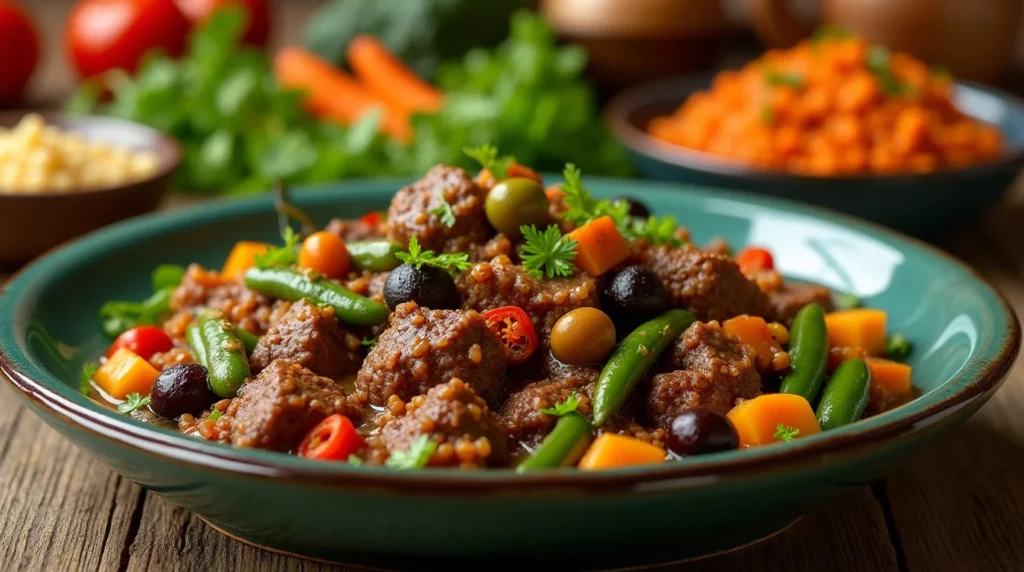
Your beef stew with vegetables is more than just tasty. It’s a nutritional powerhouse. It’s filled with north african flavors and amazing health benefits. The herbs and spices make this dish a wellness-boosting experience.
This tagine is great for your health:
- Lean beef provides high-quality protein for muscle growth
- Green beans are full of vitamins and fiber
- Olives add heart-healthy fats
- Herbs and spices have anti-inflammatory effects
North African flavors are not just about taste. They’re about nourishment. The mix of ingredients makes a balanced meal. Cumin, coriander, and turmeric in tagine recipes help with digestion and may boost the immune system.
“Food is medicine when prepared with intention and understanding” – Traditional North African Proverb
Enjoying this one-pot meal is more than just eating. It’s a way to nourish your body with centuries-old wisdom.
Conclusion
Exploring beef tagine with green beans and olives is more than just eating. It’s a journey into traditional cooking that connects you with Morocco’s rich culinary past. This dish combines rich flavors, advanced cooking techniques, and health benefits, making dinner special.
Learning this beef recipe opens a door to Moroccan cuisine’s secrets. You’ll discover the unique spice mixes, cooking styles, and cultural importance of North African food. Each ingredient has a story, and every bite carries the wisdom of generations.
Embracing traditional cooking is about more than just making a tasty meal. It’s about making connections, trying new tastes, and growing as a cook. Whether you’re an experienced chef or just starting, this dish will inspire you and please your taste buds with its true Moroccan flavor.
Begin your cooking journey today. Let the aromatic spices and tender ingredients take you to Morocco’s lively kitchens. Your taste buds will be grateful for this flavorful journey.
Enjoyed this recipe? Discover more! Explore our Mediterranean collections or try other delicious recipes to elevate your culinary experience!

